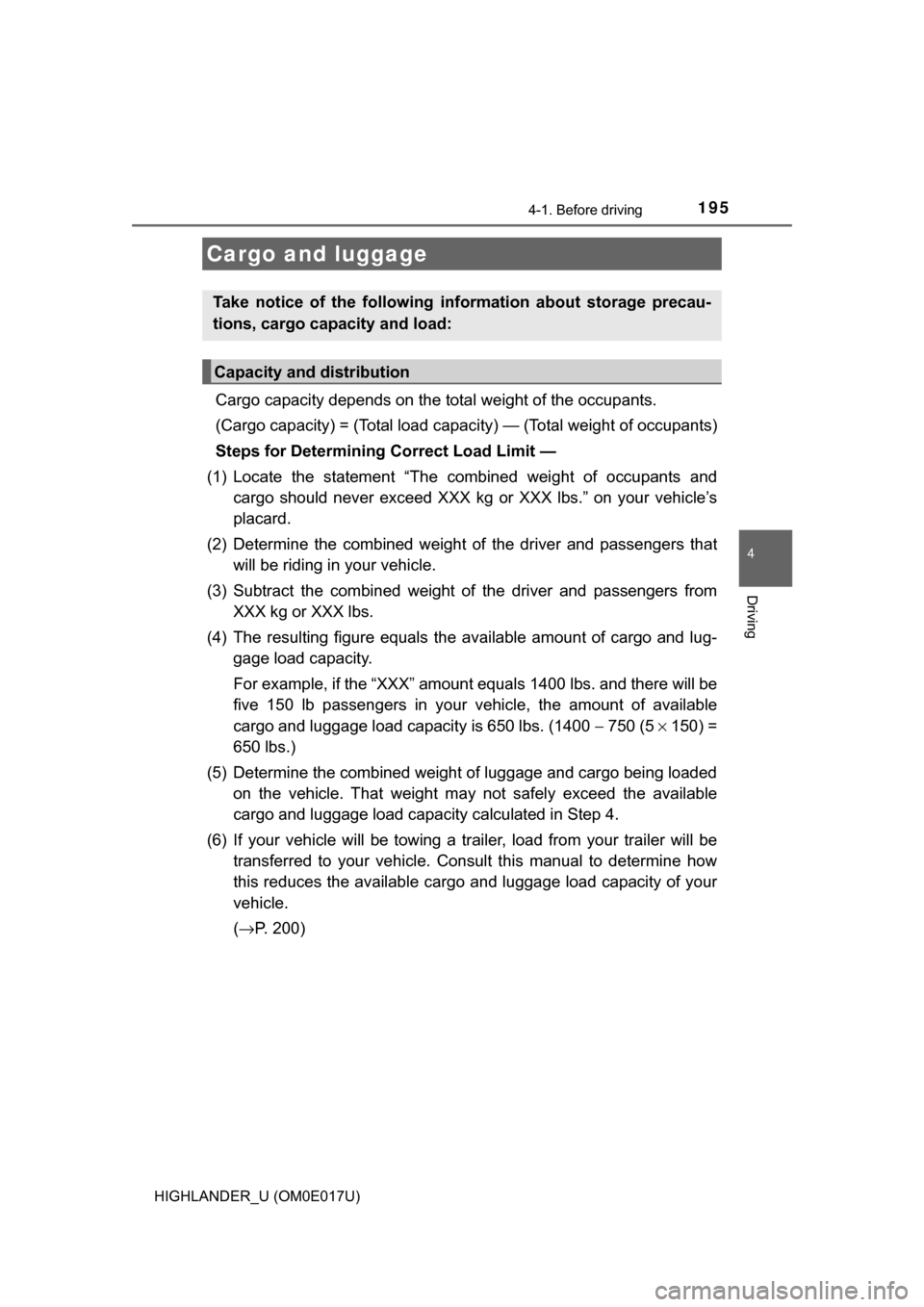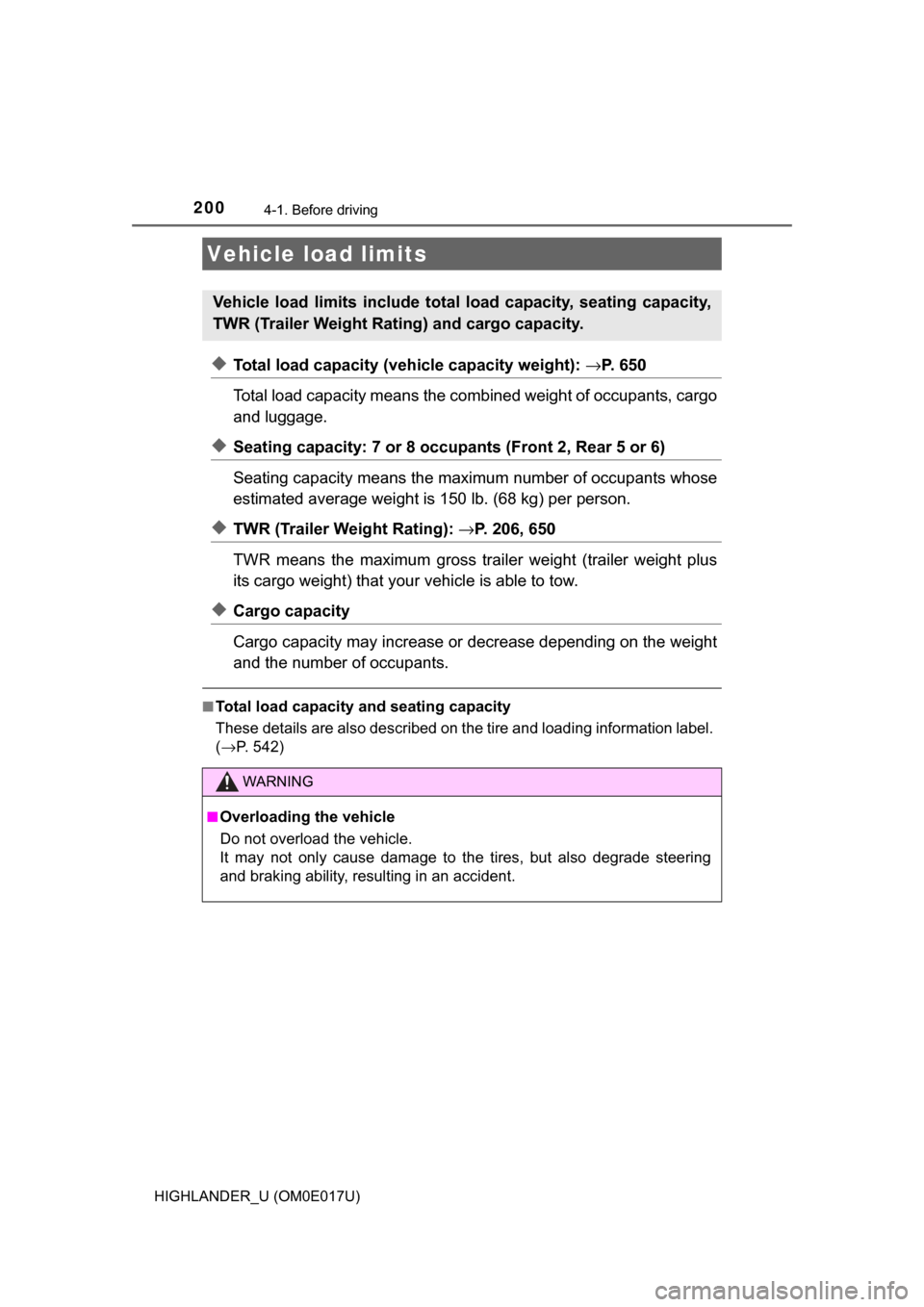Page 153 of 732
1533-3. Adjusting the seats
3
Operation of each component
HIGHLANDER_U (OM0E017U)■
Before folding down the second seats
Stow the armrest. ( →P. 478)
With a side table: Stow the side table. ( →P. 480)
Stow the second seat belt buckles.
Pass the outer seat belts
through the seat belt hangers
and secure the seat belt
plates.
This prevents the shoulder belts
from being damaged.
Make sure that the seat belts
are removed from the hangers
before using them.
Lower the head restraints to the lowest position. ( →P. 162)
Folding down the second seats
1
2
3
Without a side tableWith a side table
4
5
Page 155 of 732
1553-3. Adjusting the seats
3
Operation of each component
HIGHLANDER_U (OM0E017U)■
Returning the second seats
Lift up the seatbacks until they
lock.
■Before folding down the third seats
Stow the third seat belt buck-
les.
Pass the outer seat belts
through the seat belt hangers
and secure the seat belt
plates.
This prevents the shoulder belts
from being damaged.
Make sure that the seat belts
are removed from the hangers
before using them.
Lower the head restraints to the lowest position. ( →P. 162)
Folding down the third seats
1
2
3
Page 165 of 732
1653-3. Adjusting the seats
3
Operation of each component
HIGHLANDER_U (OM0E017U)■
Adjusting the height of the head restraints
■ Adjusting the third seat head restraints
Always raise the head restraint one level from the stowed position when
using. Make sure that the head restraints are
adjusted so that the center of the head
restraint is closest to the top of your ears.
WARNING
■Head restraint precautions
Observe the following precautions regarding the head restraints. Failure to
do so may result in death or serious injury.
● Use the head restraints designed for each respective seat.
● Adjust the head restraints to the correct position at all times.
● After adjusting the head restraints, push down on them and make sure
they are locked in position.
● Do not drive with the head restraints removed.
Page 185 of 732

185
4Driving
HIGHLANDER_U (OM0E017U)4-1. Before driving
Driving the vehicle ............. 186
Cargo and luggage ........... 195
Vehicle load limits ............. 200
Trailer towing..................... 201
Dinghy towing ................... 217
4-2. Driving procedures Engine (ignition) switch (vehicles without a
smart key system) ........... 218
Engine (ignition) switch (vehicles with a smart
key system) ..................... 221
Automatic transmission ..... 227
Turn signal lever................ 233
Parking brake .................... 234
4-3. Operating the lights and wipers
Headlight switch ................ 235
Automatic High Beam............................... 239
Fog light switch ................. 243
Windshield wipers and washer ..................... 244
Rear window wiper and washer ..................... 248 4-4. Refueling
Opening the fuel tank cap .......................... 250
4-5. Using the driving support systems
Toyota Safety Sense P .......................... 254
PCS (Pre-Collision System)........................... 261
LDA (Lane Departure Alert with steering
control) ............................ 275
Dynamic radar cruise control ............................. 285
Stop & Start system .......... 297
Rear view monitor system ............................ 307
BSM (Blind Spot Monitor) ........ 316
• BSM function ................ 321
• RCTA function .............. 324
All-wheel drive lock switch .............................. 330
Driving assist systems........................... 331
Downhill assist control system ............................ 337
4-6. Driving tips Winter driving tips ............. 339
Utility vehicle precautions ..................... 343
Page 187 of 732

1874-1. Before driving
4
Driving
HIGHLANDER_U (OM0E017U)
Make sure that the parking brake is set and shift the shift lever to D.
Gently depress the accelerator pedal.
Release the parking brake.
■When starting off on an uphill
The hill-start assist control will activate. ( →P. 331)
■ Driving in the rain
●Drive carefully when it is raining, because visibility will be reduced, the win-
dows may become fogged-up, and the road will be slippery.
● Drive carefully when it starts to rain, because the road surface will be espe-
cially slippery.
● Refrain from high speeds when driving on an expressway in the rain,
because there may be a layer of water between the tires and the road sur-
face, preventing the steering and brakes from operating properly.
■ Engine speed while driving
In the following conditions, the engine speed may become high while driving.
This is due to automatic up-shifting control or down-shifting implementation to
meet driving conditions. It does not indicate sudden acceleration.
●The vehicle is judged to be driving uphill or downhill
● When the accelerator pedal is released
■ Breaking in your new Toyota
To extend the life of the vehicle, observing the following precautions is recom-
mended:
●For the first 186 miles (300 km):
Avoid sudden stops.
● For the first 500 miles (800 km):
Do not tow a trailer.
● For the first 621 miles (1000 km):
• Do not drive at extremely high speeds.
• Avoid sudden acceleration.
• Do not drive continuously in low gears.
• Do not drive at a constant speed for extended periods.
Starting off on a steep uphill
1
2
3
Page 195 of 732

1954-1. Before driving
4
Driving
HIGHLANDER_U (OM0E017U)
Cargo capacity depends on the total weight of the occupants.
(Cargo capacity) = (Total load capacity) — (Total weight of occupants)
Steps for Determining Correct Load Limit —
(1) Locate the statement “The comb ined weight of occupants and
cargo should never exceed XXX kg or XXX lbs.” on your vehicle’s
placard.
(2) Determine the combined weight of the driver and passengers that
will be riding in your vehicle.
(3) Subtract the combined weight of the driver and passengers from
XXX kg or XXX lbs.
(4) The resulting figure equals the available amount of cargo and lug- gage load capacity.
For example, if the “ XXX” amount equals 1400 lbs. and there will be
five 150 lb passengers in your v ehicle, the amount of available
cargo and luggage load capacity is 650 lbs. (1400 − 750 (5 × 150) =
650 lbs.)
(5) Determine the combined weight of luggage and cargo being loaded on the vehicle. That weight ma y not safely exceed the available
cargo and luggage load capacity calculated in Step 4.
(6) If your vehicle will be towing a tr ailer, load from your trailer will be
transferred to your vehicle. Consult this manual to determine how
this reduces the available cargo and luggage load capacity of your
vehicle.
( → P. 200)
Cargo and luggage
Take notice of the following information about storage precau-
tions, cargo capacity and load:
Capacity and distribution
Page 197 of 732

1974-1. Before driving
4
Driving
HIGHLANDER_U (OM0E017U)
WARNING
■Things that must not be carried in the luggage compartment
The following things may cause a fire if loaded in the luggage compart-
ment:
●Receptacles containing gasoline
●Aerosol cans
■Storage precautions
Observe the following precautions.
Failure to do so may prevent the pedals from being depressed properly,
may block the driver’s vision, or may result in items hitting the driver or
passengers, possibly causing an accident.
●Stow cargo and luggage in the luggage compartment whenever possi-
ble.
●Do not stack cargo and luggage in the luggage compartment higher
than the seatbacks.
●Do not place cargo or luggage in or on the following locations.
• At the feet of the driver
• On the front passenger or rear seats (when stacking items)
• On the instrument panel
• On the dashboard
●Secure all items in the occupant compartment.
●When you fold down the rear seats, long items should not be placed
directly behind the front seats.
●Never allow anyone to ride in the luggage compartment. It is not
designed for passengers. They should ride in their seats with their seat
belts properly fastened.
Page 200 of 732

2004-1. Before driving
HIGHLANDER_U (OM0E017U)
◆Total load capacity (vehicle capacity weight): →P. 650
Total load capacity means the comb ined weight of occupants, cargo
and luggage.
◆Seating capacity: 7 or 8 occupa nts (Front 2, Rear 5 or 6)
Seating capacity means the maxi mum number of occupants whose
estimated average weight is 150 lb. (68 kg) per person.
◆TWR (Trailer Weight Rating): → P. 206, 650
TWR means the maximum gross trailer weight (trailer weight plus
its cargo weight) that your vehicle is able to tow.
◆Cargo capacity
Cargo capacity may increase or decrease depending on the weight
and the number of occupants.
■Total load capacity and seating capacity
These details are also described on the tire and loading information label.
(→ P. 542)
Vehicle load limits
Vehicle load limits include total load capacity, seating capacity,
TWR (Trailer Weight Rating) and cargo capacity.
WARNING
■Overloading the vehicle
Do not overload the vehicle.
It may not only cause damage to the tires, but also degrade steering
and braking ability, resu lting in an accident.